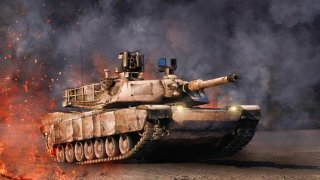Ukraine’s 'Masterstroke' Kursk Offensive Is About Geometry, not Geography
Ukraine’s Kursk offensive was a tactical masterstroke that changed the geometry of the battlefield by extending Russian lines and obliging them to rethink their force allocation assumptions. This changes the military calculus.
Countless pundits have denigrated Ukraine’s Kursk offensive, and nearly all the criticism has focused on geography: Sudzha, Pokrovsk, Kursk. But this misses the point. The offensive is not about geography. It’s about geometry.
Ukraine’s Kursk offensive was a tactical masterstroke that changed the geometry of the battlefield by extending Russian lines and obliging them to rethink their force allocation assumptions. This changes the military calculus. It has led to immediate tactical and operational benefits, and if Ukraine can consolidate the gains it has made, it holds the possibility of strategic benefits, as well.
Since Ukraine’s failed 2023 counteroffensive, the frontline has remained relatively static.
Russia established an operational tempo that enabled small, consistent gains, and it seemed poised to continue this grinding war of attrition indefinitely. When an enemy is making consistent gains, something must be done to disrupt their operations. Ukraine’s Kursk offensive did just that.
Tactically, Ukraine’s Kursk offensive demonstrates a masterful use of the characteristics of offensive operations: audacity, surprise, concentration, and tempo. By following Sun Tzu’s advice to strike where the enemy is weak, Ukraine has gained in just one month as much land as Russia gained in its grinding 2024 offensive operations.
Operationally, the Kursk offensive has forced Russia to divert forces from its offensive operations to allow for the creation of defenses where previously they were all but nonexistent, and it has provided a new angle of attack against Russian forces supporting offensive operations against Kharkiv.
Geometry, Its Just Math at the End of the Day
As Russia is forced to move its forces along the outside edge of the long, curved frontline to defend its border, Ukraine can take advantage of its interior lines of communication to move personnel and supplies more nimbly than Russia.
Finally, there are clear strategic benefits. First, taking the fight to Russian land provides an important morale boost for Ukrainian soldiers and civilians who have not seen significant battlefield victories since 2022. These gains, if consolidated, give Ukraine something to exchange at a negotiating table.
Taking the fight to Russian territory forced Russian president Vladimir Putin to use conscripts, something he has studiously avoided to this point. The mere fact of Ukraine’s invasion led to finger-pointing and anger within the Putin administration. Finally, the offensive demonstrated that Western fears of Russian red lines remain overblown. Taken together, these benefits have allowed Kyiv to change the narrative and build a theory of victory.
These gains were not achieved without risk. It was risky to commit reserve forces to an offensive rather than defensive action and doing so may have cleared Russia’s path to take Pokrovsk. While Pokrovsk is important, similar claims about the strategic importance of a town have been made at various times throughout this war, for example, about Mariupol and Avdiivka. But without risk, there is no reward.
U.S. Army doctrine states that “audacity is a willingness to take bold risks. The offense favors the bold execution of plans.”
This does not mean seeking or taking unnecessary risks. But it does mean taking bold action to seize opportunities. Ukraine saw an opportunity in Russia’s disorganized defenses, and it had a choice. It could choose to commit its reserves to a grinding defense of Pokrovsk, which even if successful would represent a tactical and perhaps operational win, but would present no strategic benefits. Alternatively, it could commit its forces to the tactical and operational benefits in Kursk, disrupt Russia’s operational tempo, and create a strategic dilemma for the Russian military.
I believe Ukraine made the correct decision in attacking Kursk, but making the right decision in war does not guarantee positive outcomes. The critical question now is whether Ukraine will be able to take advantage of the new geometry on the battlefield by consolidating the gains it has made in Kursk. If Ukraine can dig in defenses, it will force Russia to continue using poorly trained conscripts, divert Russian forces from the frontline in Ukraine, and lead to continued Russian bombing of its territory in an attempt to take it back.
About the Author
Ann Marie Dailey is a policy researcher at the RAND Corporation, a nonresident senior fellow at the Transatlantic Security Initiative of the Atlantic Council’s Scowcroft Center for Strategy and Security, and an engineer officer in the U.S. Army Reserves.
Image Credit: Creative Commons and/or Shutterstock


